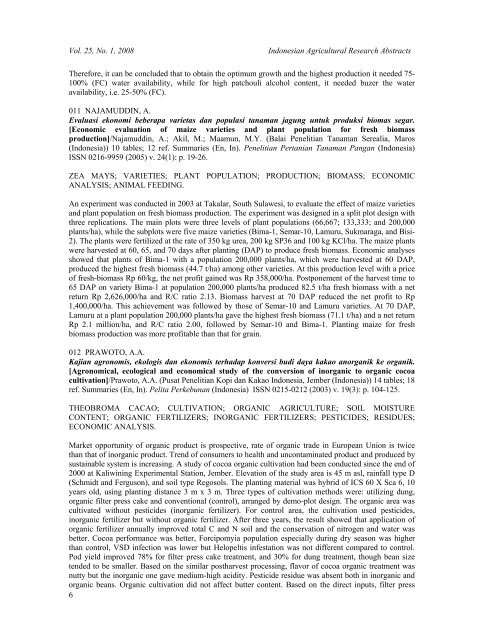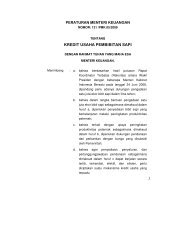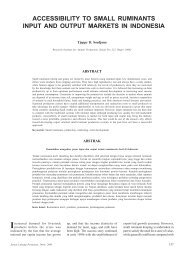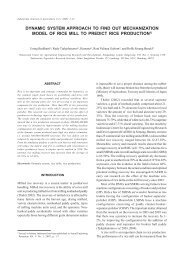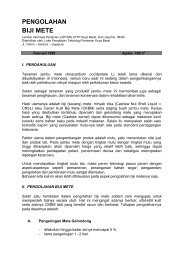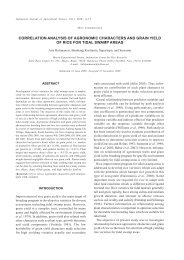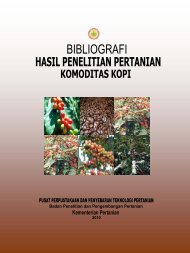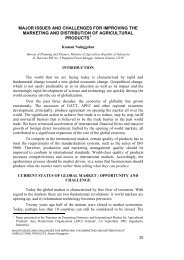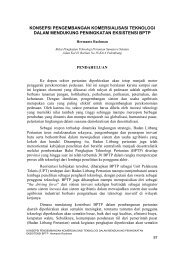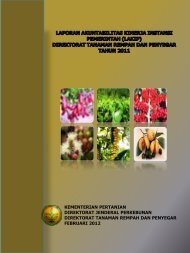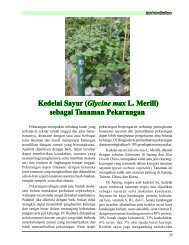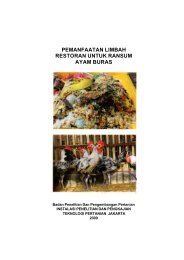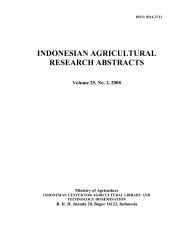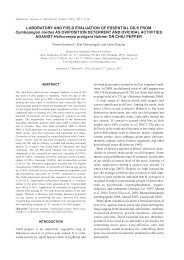IARA Vol. XXV No. 1 Year. 2008 (pdf, 1000 kb) - Pustaka Deptan
IARA Vol. XXV No. 1 Year. 2008 (pdf, 1000 kb) - Pustaka Deptan
IARA Vol. XXV No. 1 Year. 2008 (pdf, 1000 kb) - Pustaka Deptan
Create successful ePaper yourself
Turn your PDF publications into a flip-book with our unique Google optimized e-Paper software.
<strong>Vol</strong>. 25, <strong>No</strong>. 1, <strong>2008</strong><br />
Indonesian Agricultural Research Abstracts<br />
Therefore, it can be concluded that to obtain the optimum growth and the highest production it needed 75-<br />
100% (FC) water availability, while for high patchouli alcohol content, it needed buzer the water<br />
availability, i.e. 25-50% (FC).<br />
011 NAJAMUDDIN, A.<br />
Evaluasi ekonomi beberapa varietas dan populasi tanaman jagung untuk produksi biomas segar.<br />
[Economic evaluation of maize varieties and plant population for fresh biomass<br />
production]/Najamuddin, A.; Akil, M.; Maamun, M.Y. (Balai Penelitian Tanaman Serealia, Maros<br />
(Indonesia)) 10 tables; 12 ref. Summaries (En, In). Penelitian Pertanian Tanaman Pangan (Indonesia)<br />
ISSN 0216-9959 (2005) v. 24(1): p. 19-26.<br />
ZEA MAYS; VARIETIES; PLANT POPULATION; PRODUCTION; BIOMASS; ECONOMIC<br />
ANALYSIS; ANIMAL FEEDING.<br />
An experiment was conducted in 2003 at Takalar, South Sulawesi, to evaluate the effect of maize varieties<br />
and plant population on fresh biomass production. The experiment was designed in a split plot design with<br />
three replications. The main plots were three levels of plant populations (66,667; 133,333; and 200,000<br />
plants/ha), while the subplots were five maize varieties (Bima-1, Semar-10, Lamuru, Sukmaraga, and Bisi-<br />
2). The plants were fertilized at the rate of 350 kg urea, 200 kg SP36 and 100 kg KCl/ha. The maize plants<br />
were harvested at 60, 65, and 70 days after planting (DAP) to produce fresh biomass. Economic analyses<br />
showed that plants of Bima-1 with a population 200,000 plants/ha, which were harvested at 60 DAP,<br />
produced the highest fresh biomass (44.7 t/ha) among other varieties. At this production level with a price<br />
of fresh-biomass Rp 60/kg, the net profit gained was Rp 358,000/ha. Postponement of the harvest time to<br />
65 DAP on variety Bima-1 at population 200,000 plants/ha produced 82.5 t/ha fresh biomass with a net<br />
return Rp 2,626,000/ha and R/C ratio 2.13. Biomass harvest at 70 DAP reduced the net profit to Rp<br />
1,400,000/ha. This achievement was followed by those of Semar-10 and Lamuru varieties. At 70 DAP,<br />
Lamuru at a plant population 200,000 plants/ha gave the highest fresh biomass (71.1 t/ha) and a net return<br />
Rp 2.1 million/ha, and R/C ratio 2.00, followed by Semar-10 and Bima-1. Planting maize for fresh<br />
biomass production was more profitable than that for grain.<br />
012 PRAWOTO, A.A.<br />
Kajian agronomis, ekologis dan ekonomis terhadap konversi budi daya kakao anorganik ke organik.<br />
[Agronomical, ecological and economical study of the conversion of inorganic to organic cocoa<br />
cultivation]/Prawoto, A.A. (Pusat Penelitian Kopi dan Kakao Indonesia, Jember (Indonesia)) 14 tables; 18<br />
ref. Summaries (En, In). Pelita Perkebunan (Indonesia) ISSN 0215-0212 (2003) v. 19(3): p. 104-125.<br />
THEOBROMA CACAO; CULTIVATION; ORGANIC AGRICULTURE; SOIL MOISTURE<br />
CONTENT; ORGANIC FERTILIZERS; INORGANIC FERTILIZERS; PESTICIDES; RESIDUES;<br />
ECONOMIC ANALYSIS.<br />
Market opportunity of organic product is prospective, rate of organic trade in European Union is twice<br />
than that of inorganic product. Trend of consumers to health and uncontaminated product and produced by<br />
sustainable system is increasing. A study of cocoa organic cultivation had been conducted since the end of<br />
2000 at Kaliwining Experimental Station, Jember. Elevation of the study area is 45 m asl, rainfall type D<br />
(Schmidt and Ferguson), and soil type Regosols. The planting material was hybrid of ICS 60 X Sca 6, 10<br />
years old, using planting distance 3 m x 3 m. Three types of cultivation methods were: utilizing dung,<br />
organic filter press cake and conventional (control), arranged by demo-plot design. The organic area was<br />
cultivated without pesticides (inorganic fertilizer). For control area, the cultivation used pesticides,<br />
inorganic fertilizer but without organic fertilizer. After three years, the result showed that application of<br />
organic fertilizer annually improved total C and N soil and the conservation of nitrogen and water was<br />
better. Cocoa performance was better, Forcipomyia population especially during dry season was higher<br />
than control, VSD infection was lower but Helopeltis infestation was not different compared to control.<br />
Pod yield improved 78% for filter press cake treatment, and 30% for dung treatment, though bean size<br />
tended to be smaller. Based on the similar postharvest processing, flavor of cocoa organic treatment was<br />
nutty but the inorganic one gave medium-high acidity. Pesticide residue was absent both in inorganic and<br />
organic beans. Organic cultivation did not affect butter content. Based on the direct inputs, filter press<br />
6


